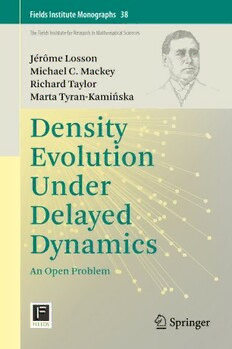Table Of ContentFields Institute Monographs 38
The Fields Institute for Research in Mathematical Sciences
Jérôme Losson
Michael C. Mackey
Richard Taylor
Marta Tyran-Kamińska
Density
Evolution
Under
Delayed
Dynamics
An Open Problem
Fields Institute Monographs
VOLUME 38
TheFieldsInstituteforResearchinMathematicalSciences
FieldsInstituteEditorialBoard:
KumarMurty,Director
DeirdreHaskell,DeputyDirectoroftheInstitute
JamesG.Arthur,UniversityofToronto
KennethR.Davidson,UniversityofWaterloo
LisaJeffrey,UniversityofToronto
BarbaraLeeKeyfitz,OhioStateUniversity
ThomasS.Salisbury,YorkUniversity
NorikoYui,Queen’sUniversity
JurisSteprans,YorkUniversity
TheFieldsInstituteisacentreforresearchinthemathematicalsciences,locatedin
Toronto,Canada.TheInstitutesmissionistoadvanceglobalmathematicalactivity
intheareasofresearch,educationandinnovation.TheFieldsInstituteissupported
bytheOntarioMinistryofTraining,CollegesandUniversities,theNaturalSciences
and Engineering Research Council of Canada, and seven Principal Sponsoring
UniversitiesinOntario(Carleton,McMaster,Ottawa,Queen’s,Toronto,Waterloo,
WesternandYork),aswellasbyagrowinglistofAffiliateUniversitiesinCanada,
theU.S.andEurope,andseveralcommercialandindustrialpartners.
Moreinformationaboutthisseriesathttp://www.springer.com/series/10502
Jérôme Losson • Michael C. Mackey
Richard Taylor • Marta Tyran-Kamin´ska
Density Evolution Under
Delayed Dynamics
An Open Problem
JérômeLosson MichaelC.Mackey
BCPartners DepartmentofPhysiology
London,UK McGillUniversity
Montreal,QC,Canada
RichardTaylor
DepartmentofMathematicsandStatistics MartaTyran-Kamin´ska
ThompsonRiversUniversity InstituteofMathematics
Kamloops,BC,Canada UniversityofSilesia
Katowice,Poland
ISSN1069-5273 ISSN2194-3079 (electronic)
FieldsInstituteMonographs
ISBN978-1-0716-1071-8 ISBN978-1-0716-1072-5 (eBook)
https://doi.org/10.1007/978-1-0716-1072-5
©SpringerScience+BusinessMedia,LLC,partofSpringerNature 2020
Thisworkissubjecttocopyright.AllrightsarereservedbythePublisher,whetherthewholeorpartof
thematerialisconcerned,specificallytherightsoftranslation,reprinting,reuseofillustrations,recitation,
broadcasting,reproductiononmicrofilmsorinanyotherphysicalway,andtransmissionorinformation
storageandretrieval,electronicadaptation,computersoftware,orbysimilarordissimilarmethodology
nowknownorhereafterdeveloped.
Theuseofgeneraldescriptivenames,registerednames,trademarks,servicemarks,etc.inthispublication
doesnotimply,evenintheabsenceofaspecificstatement,thatsuchnamesareexemptfromtherelevant
protectivelawsandregulationsandthereforefreeforgeneraluse.
Thepublisher,theauthors,andtheeditorsaresafetoassumethattheadviceandinformationinthisbook
arebelievedtobetrueandaccurateatthedateofpublication.Neitherthepublishernortheauthorsor
theeditorsgiveawarranty,expressedorimplied,withrespecttothematerialcontainedhereinorforany
errorsoromissionsthatmayhavebeenmade.Thepublisherremainsneutralwithregardtojurisdictional
claimsinpublishedmapsandinstitutionalaffiliations.
ThisSpringerimprintispublishedbytheregisteredcompanySpringerScience+BusinessMedia,LLC,
partofSpringerNature.
Theregisteredcompanyaddressis:1NewYorkPlaza,NewYork,NY10004,U.S.A.
Preface
This monograph has arisen out of a number of attempts spanning almost five
decadestounderstandhowonemightexaminetheevolutionofdensitiesinsystems
whose dynamics are described by differential delay equations. Though we have
no definitive solution to the problem, we offer this contribution in an attempt to
define the problem as we see it and to sketch out several obvious attempts that
havebeensuggestedtosolvetheproblemandwhichseemtohavefailed.Wehope
that by being available to the general mathematical community, they will inspire
otherstoconsider—andhopefullysolve—theproblem.Seriousattemptshavebeen
made by all of the authors over the years and we have made reference to these
where appropriate. Much of the material in this contribution has been previously
published,butnotallofit.AseriousattempthasbeenmadebyTaylor(2004)and
shouldbeconsultedforavarietyofissues,someofwhicharerepeatedhere.Along
thesamelines,manyofthetopicsweraiseherearealsohighlightedinMitkowski
andMitkowski(2012),andinMitkowski(2021).
Thematerialisorganizedasfollows:
Chapter 1 offers motivating examples to show why we want to study density
evolutioninsystemswithdelayeddynamics.
InChap.2,wereviewbrieflywhatisknownaboutdensityevolutioninsystems
with finite dimensional dynamics, starting with a description of the connection
between dynamics and densities in Sect.2.1. Section 2.3 reviews the situation for
the commonly known situation in which the dynamics are described by ordinary
differentialequations.Section2.4brieflyconsidersdynamicsdescribedbystochas-
ticdifferentialequations,whileSect.2.5doesthesameforfinite-dimensionalmaps.
Section2.6concludeswithadescriptionofthedynamicdensityevolutionbehaviors
ofergodicity,mixing,exactness,andasymptoticperiodicity.
Chapter3motivatesthestudyofthedynamicsofensemblesofdifferentialdelay
equationsthroughsomesimplenumericalexamples.Section3.1relatestheformal
“density evolution” problem for differential delay equations to what is actually
measured in an experimental setting. Section 3.2 gives numerical evidence for the
existence of interesting ergodic properties of density evolution dynamics in the
presence of delays. Chapter 4 considers the real mathematical problems involved
v
vi Preface
rangingfromthepropernatureoftheunderlyingspacetotheproblemofdefininga
densityandhighlightsalloftheproblemsattendantindoingso.Chapter5outlines
anapproachthathasbeentriedbasedontheHopffunctional.Section5.1introduces
thenotionofHopffunctionals,andSect.5.2appliesthistothespecificcaseofdelay
differentialequations.
Chapter 6 considers the problem reformulated as the method of steps. Finally,
Chap.7considerstheapproximationstothedelayproblem,firstexaminingahigh-
dimensional map approximation to the delay equation. Chapter 8 is devoted to
developing approximate Liouville-like equations and an examination of invariant
densitiesfordifferentialdelayequations.WeconcludeinChap.9.
We are indebted to numerous colleagues with whom we have discussed this
problem over the years. We would like, in particular, to thank Andrzej Lasota
(1932–2006), André Longtin, and Helmut Schwegler. The impetus for writing
this is in large part due to a month-long workshop “Short Thematic Program on
DelayDifferentialEquations”heldattheFieldsInstitute(Toronto,May,2015)and
organizedbyProf.JianhongWu(YorkUniversity).Manycolleaguesthereoffered
commentsandsuggestions,andforthatwethankthem,whileothercolleagueshave
generouslysharedtheirworkwithusaheadofpublication.
This work was supported at various times by NATO, MITACS (Canada), the
Humboldt Stiftung (Germany), the Natural Sciences and Engineering Research
Council(NSERC,Canada),andthePolishNCNgrantno.2017/27/B/ST1/00100.
London,UK JérômeLosson
Montreal,QC,Canada MichaelC.Mackey
Kamloops,BC,Canada RichardTaylor
Katowice,Poland MartaTyran-Kamin´ska
June2020
Contents
PartI Introduction and Background to Density Evolution
Problems
1 IntroductionandMotivation ............................................... 3
1.1 Summary ................................................................ 8
2 DensityEvolutioninSystemswithFinite-DimensionalDynamics ..... 9
2.1 DynamicsandDensities ................................................ 9
2.2 Frobenius–PerronOperator............................................. 10
2.3 TheLiouvilleEquation ................................................. 11
2.4 TheFokker–PlanckEquation........................................... 11
2.5 DensityEvolutioninMaps ............................................. 12
2.6 TheDynamicsofDensityEvolution................................... 13
2.7 Summary ................................................................ 16
PartII Illustrating the Problem and Making It Precise for
DifferentialDelayEquations
3 DynamicsinEnsemblesofDifferentialDelayEquations................ 19
3.1 WhatDoWeMeasure? ................................................. 19
3.2 Numerical Evidence for Interesting Density Dynamics
inDifferentialDelayEquations ........................................ 21
3.3 Summary ................................................................ 26
4 TheProblem.................................................................. 29
4.1 Introduction ............................................................. 29
4.2 DelayDifferentialEquations ........................................... 29
4.2.1 DefinitionofaSolution......................................... 30
4.2.2 MethodofSteps................................................. 31
4.3 DelayEquationasaDynamicalSystem ............................... 31
4.4 Frobenius–PerronOperator............................................. 33
4.5 ProbabilityinInfinite-DimensionalSpaces............................ 34
4.5.1 Appropriateσ-Algebra......................................... 35
vii
viii Contents
4.5.2 Densities......................................................... 36
4.5.3 Lackofa“Natural”MeasureonC ............................ 37
4.5.4 WienerMeasure................................................. 38
4.6 Conclusions ............................................................. 40
PartIII PossibleAnalyticalApproaches
5 TheHopfFunctionalApproach............................................ 45
5.1 HopfCharacteristicFunctionalsandFunctionalDifferential
Equations................................................................ 45
5.1.1 FunctionalsandFunctionalDerivatives ....................... 46
5.1.2 HopfCharacteristicFunctionals ............................... 48
5.1.3 HopfCharacteristicFunctionalsandPartialDifferential
Equations........................................................ 53
5.2 CharacteristicFunctionalsforDelayEquations....................... 60
5.2.1 AFunctionalDifferentialEquationforZ .................... 63
t
5.2.2 TheMomentsoftheMeasureW ............................. 65
t
5.2.3 TaylorSeriesExpansionoftheFunctionalZ ................ 66
t
5.2.4 PartialDifferentialEquationsfortheMoments............... 67
5.2.5 InvariantMeasures.............................................. 73
5.2.6 TheHopfEquationandtheKramers–MoyalExpansion ..... 73
5.3 DiscussionandConclusions............................................ 78
6 TheMethodofSteps......................................................... 79
6.1 OrdinaryDifferentialEquationSystem................................ 80
6.1.1 MethodofSteps................................................. 80
6.1.2 ModifiedMethodofSteps...................................... 81
6.2 ContinuityEquation..................................................... 83
6.3 MethodofCharacteristics .............................................. 83
6.3.1 AlternativeFormulation........................................ 86
6.4 GeometricInterpretation................................................ 87
6.5 MethodsofStepsandPiecewiseDeterministicMarkovProcesses... 88
6.6 SummaryandConclusions ............................................. 95
PartIV PossibleApproximatingSolutions
7 TurningaDifferentialDelayEquationintoaHigh-DimensionalMap 99
7.1 FromDifferentialDelaytoOrdinaryDifferentialEquations ......... 100
7.1.1 FunctionsofBoundedVariation ............................... 104
7.1.2 TheResultofIonescuTulceaandMarinescu ................. 105
7.2 ApplicationstoDifferentialDelayEquations ......................... 107
7.2.1 OscillatorySolutionsandExpansionRequirements .......... 107
7.2.2 TheResult....................................................... 108
7.3 SummaryandConclusions ............................................. 114
Contents ix
8 Approximate“Liouville-Like”EquationandInvariantDensities
forDelayDifferentialEquations ........................................... 115
8.1 DiscretizedFrobenius–PerronOperator ............................... 115
8.2 Liouville-LikeEquation ................................................ 117
8.3 InvariantDensities ...................................................... 118
8.4 Copulas.................................................................. 119
8.5 ApproximateInvariantDensities....................................... 120
8.6 Examples ................................................................ 122
9 SummaryandConclusions ................................................. 131
References......................................................................... 133
Index............................................................................... 137
Part I
Introduction and Background to Density
Evolution Problems
Chapter 1 is an introductory section in which we set the stage for defining the
problems of density evolution under the action of differential delay equations and
motivatingwhywewanttolookatit.
Chapter 2 (page 9) talks briefly about density evolution in systems with finite-
dimensional dynamics, starting with a description of the connection between
dynamics and densities in Sect.2.1. Section 2.3 reviews the situation for the
commonly known situation in which the dynamics are described by ordinary dif-
ferentialequations.Section2.4brieflyconsidersdynamicsdescribedbystochastic
differential equations, while 2.5 does the same for finite-dimensional maps. This
chapter concludes in Sect.2.6 with a description of the dynamic density evolution
behaviorsofergodicity,mixing,exactness,andasymptoticperiodicity.

